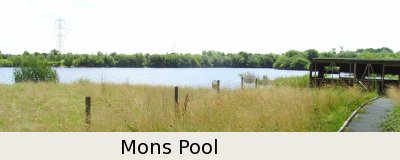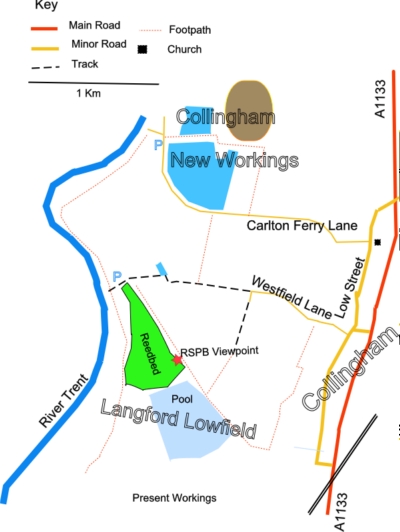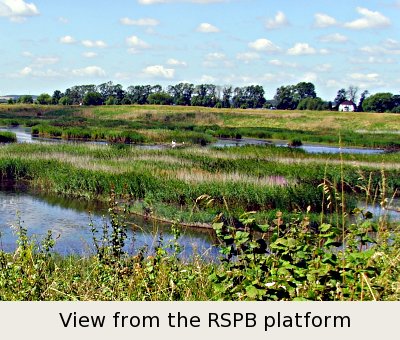
Below are three guides to working and expired aggregate pits on the east side if the river Trent, north of Newark. They are all fairly close together and all are set in the same type of habitat. This is mainly arable farmland with hawthorn hedges and apart from the existence of the gravel pits would attract the same bird species, such as Yellow Hammers, Linnets, Goldfinches, Chaffinches, Blackbirds and in the summer Common Whitethroats and Willlow Warblers. Flocks of Lapwings and Golden Plover (can be 1000+ ) occur in the winter in the weather is not too hard. An American Golden Plover was present in September and October in 2000. The presence of Gravel Pits has increased the attractiveness of the area to the birdwatcher quite a bit, with the breeding Cormorants at Besthorpe, Sand Martin colonies, suitable habitat for passage waders, large areas of reedbeds and open water for ducks and grebes.
From the A1133 Newark to Gainsborough road, take the southernmost turn into Besthorpe Village towards the west (or river Trent), and then almost immediately left down Trent Lane. Carry on along Trent Lane and after about 300m take the second track on the left, this has a sign for Besthorpe Nature Reserve. About 400m along the track is the car park.

This is the only one of the three featured sites with facilities for the disabled. A hide overlooking a pool, which is reached by a boardwalk, is now in front of you. A path also goes to the right and around half of Mons Pool as the water is known. This path is not suitable for disabled access.
Besthorpe Nature Reserve is leased and managed by the Nottinghamshire Wildlife Trust.
Mons Pool is a worked out gravel pit surrounded by grassland and trees such as Willow, Hawthorn and Ash. Besthorpe Meadow lies to the west of the access road and is managed as a wildflower/hay area.
Nesting Cormorants and Grey Herons are the big attraction here. The Cormorant site is one of the largest inland nesting sites in England. Sedge Warblers, Blackcaps, Willow Warblers and Common Whitethroats are some of the summer visitors here. Turtle Doves appear to be commoner here than in most parts of Nottinghamshire.
This lies a few hundred yards to the north of Trent Lane and is the old works area from when the pits were being excavated. The land dried out and lost much of its appeal. However in 2011 the area has been re-profiled and reeds planted. Unfortunately the attractiveness of the area is still threatened by the dry summer of 2011.
Collingham New Workings is also known as Besthorpe Quarry.

Go to Collingham via the A1133 Newark to Gainsborough road. In Collingham, take Low Street which is the last exit on the west at the north end of the village, turn west opposite All Saints church into the lane signposted “River Trent”. This is Trent Lane (which becomes Carlton Ferry Lane) and eventually leads to a small anglers car park by the Trent. This track passes some old gravel pits which are to the south of the Mons Pit (see the Besthorpe section above). These pits are not shown on the map on the left.
However for Collingham new workings, we only want to go c1 mile along Trent Lane from Collingham. This is just before the asphalted road changes into a hardcore surfaced track. On the right hand side of the road one of the pits is visible through the hedge. On the left hand side is an angler’s track to the Trent and a white house set back from the road. Also here is a horse paddock and a sign saying “Dog Grooming Studio“, park in this area and look on the right hand side for a style or a gap in the hedge, once through the hedge there is a footbridge over a dyke and a public footpath between two gravel pits, with the right hand one still retaining some gravel islands. Following the footpath further down beyond these two pits and over a quarry track is another dryer quarry on the left. Going through the hedge at the end of this path is a bridlepath, from here you can either turn left or right to make a circular walk. Left will take you around the Collingham quarry works and back to Carlton Ferry lane (here an unmetaled road), right will take you by Ferry Farm pit and Ferry Farm back to the asphalted part of Carlton Ferry lane. On your return this way, check through the hedge. There are some pools here which can attract waders.
The main attraction here is passage waders, this is best in the months April – May in the spring and late July – early October in the autumn. These are the usual Green Sandpipers, Common Sandpiper and Dunlin but also Wood Sandpiper, Ruff and Little Stint have appeared. Little Egrets are regular in late summer, probably commuting between here and Langford Lowfields. There are several Sand Martin colonies in the area. The weedier areas are attractive to finches.
Rare birds have included:This site has two distinctions, it will be the only RSPB reserve in Nottinghamshire when it opens in 2017 or thereabouts. It is also a working gravel pit which is being shaped to make it to make it attractive to wildlife when extraction has finished.
See the map in the Collingham section. Travel to Collingham on the A1133 Newark to Gainsborough road, in Collingham turn west at “The Green”. The Green is more like a grassy triangle at the south end of the village, and if you are travelling north from Newark it is the first road on the left after entering the built up area of Collingham village. Follow this road to the left and take the first road on the right signposted ‘The River Trent’. This is Westfield Lane. Follow this lane to the car park at the end. The road is asphalted to begin with, but around 1/3rd of the way, by a farm, it becomes a hardcore surfaced track and very bumpy. If your constitution or your car is not up to the ride, then there are various alternatives. You can either park around Westfield Farm and walk down the track to the angler‘s car park by the Trent or take the track by the houses which leads to a path by the side of an arable field. Take the left hand side of the hedge in front of you. This footpath may be difficult when the crops are growing in the summer. Thirdly park by Collingham new workings and use the footpaths through the fields. Langford Lowlands quarry is to the south of the car park.

Although there are two public footpaths alongside the pits, one by the river Trent and the other running alongside a hedge on the eastern side, views of the lagoons are poor. The best place is a viewpoint, built by the RSPB, about 500 metres along the eastern footpath which gives excellent views over part of the reedbeds. Another 100 metres in the same direction, the path overlooks a pool with a “beach”, which can give good views of loafing gulls and waders. The beach is formed by the washings from the gravel workings.
The eastern footpath can be hard to find in the summer with the growth of vegetation, but can be found 100 metres back along the road from the carpark. Here hidden in the scrub is the style and the footpath signpost , a machete would be useful!
Sand and gravel extraction started in 1989 and the latest estimate is that extraction will be completed around 2017, but this is dependent on the amount of material on the site. The area was originally intensive arable farmland with little wildlife interest. In 1995 human remains were found which were dated back to the bronze age. Finds of human skeletons are very rare in the East Midlands because of the generally acid soil.
The RSPB reserve will be around 170 ha when finally established, consisting of 52 ha of reedbed, 22 ha of grassland, 17 ha of open water, 4 ha of scrub plus 3.5ha of already existing woodland. The remainder of the area will be taken up by the carpark and large plastic redbreasted birds with slots in their heads to accept coins.
The RSPB does not intend having a shop or large visitor centre on the site. The main purpose of this reserve is to create enough reedbed to support 2 or 3 pairs of breeding Bitterns.
Winter 200+ Teal, 20+ Pintail, Water Rail, Regular wintering drake Green-winged Teal (2004 -> 2006), Short eared Owls.
Summer Occasional Garganey. Little Egrets are regular in late summer. Avocet
Passage Sanderling, Little Stint, Jack Snipe have occurred. More regular are Ringed Plover, Ruff and Snipe.
Rare birds have included:Any criticisms, corrections or comments to the author Derek Huskisson

This work is licensed under a Creative Commons Attribution-Noncommercial-Share Alike 2.0 UK: England & Wales License.